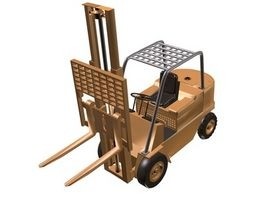Forklift Safety Tips & Rules

According to The Hartford, an estimated 20,000 people are injured and 100 people are killed each year from forklift-related accidents. Sadly, many of these deaths could have been prevented with proper training. In fact, workplace safety can dramatically increase by following basic safety tips and rules when operating a forklift. Following simple maintenance and operation procedures may even save a life.
Training
No one under the age of 18 may operate a forklift. It is the responsibility of the employer to ensure that an employee has gone through a proper training program and receive a certificate upon completion of that program. The program will consist of lectures, presentations, discussions, and actual operation of the forklift. Forklift operators should be reevaluated every three years to ensure proficiency with forklift safety rules. According to The Hartford, a complete forklift training class will cover four areas: general dangers of forklift operations, hazards of the workplace, the dangers of surface and lighting in the workplace, and specific dangers of operating the particular forklift that will be used.
Maintenance
A forklift should be inspected every day to ensure it is functioning properly. A checklist of items should be created when inspecting a forklift. Any problems should be reported immediately and the forklift should be repaired. The Workplace
The workplace should be designed and inspected to facilitate forklift safety. Forklift-only "traffic lanes" should be designated, warning systems should be in place to alert employees when there is an oncoming forklift (i.e. horns and flashing lights), and forklift docking stations should be inspected for damage.
General Guidelines
There are several general guidelines that must be followed to ensure safety when operating a forklift. First, the load capacity of the forklift should never be exceeded. Second, drivers and passengers should keep all appendages inside the vehicle. Also, any known hazards, such as wet spots or oil spills on the ground, should be avoided. Third, only raise or lower the load while the forklift is not moving. Finally, ensure that the forklift has enough clearance with the load on board.
Training
No one under the age of 18 may operate a forklift. It is the responsibility of the employer to ensure that an employee has gone through a proper training program and receive a certificate upon completion of that program. The program will consist of lectures, presentations, discussions, and actual operation of the forklift. Forklift operators should be reevaluated every three years to ensure proficiency with forklift safety rules. According to The Hartford, a complete forklift training class will cover four areas: general dangers of forklift operations, hazards of the workplace, the dangers of surface and lighting in the workplace, and specific dangers of operating the particular forklift that will be used.
Maintenance
A forklift should be inspected every day to ensure it is functioning properly. A checklist of items should be created when inspecting a forklift. Any problems should be reported immediately and the forklift should be repaired. The Workplace
The workplace should be designed and inspected to facilitate forklift safety. Forklift-only "traffic lanes" should be designated, warning systems should be in place to alert employees when there is an oncoming forklift (i.e. horns and flashing lights), and forklift docking stations should be inspected for damage.
General Guidelines
There are several general guidelines that must be followed to ensure safety when operating a forklift. First, the load capacity of the forklift should never be exceeded. Second, drivers and passengers should keep all appendages inside the vehicle. Also, any known hazards, such as wet spots or oil spills on the ground, should be avoided. Third, only raise or lower the load while the forklift is not moving. Finally, ensure that the forklift has enough clearance with the load on board.
- jk94f223a57bd16c1490a858b1ea563122.jpg
References
http://www.ehow.com/list_6072051_forklift-safety-tips-rules.html
http://img.ehowcdn.com/615x200/ehow/images/a05/p9/nj/forklift-safety-tips-rules-1.1-800x800.jpg